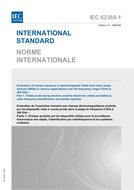Click here to purchase
IEC 62369-1:2008 presents procedures for the evaluation of human exposure to electromagnetic fields (EMFs) from devices used in electronic article surveillance (EAS), radio frequency identification (RFID) and similar applications. It adopts a staged approach to facilitate compliance assessment. The first stage (Stage 1) is a simple measurement against the appropriate derived reference values. Stage 2 is a more complex series of measurements or calculations, coupled with analysis techniques. Stage 3 requires detailed modelling and analysis for comparison with the basic restrictions. When assessing any device, the most appropriate methodfor the exposure situation may be used. At the time of writing this International Standard, electronic article surveillance, radio frequency identification and similar systems do not normally operate at frequencies below 1 Hz or above 10 GHz. EMF exposure guidelines and standards can cover a wider range of frequencies, so clarification on the required range is included as part of the evaluation procedures. The devices covered by this document normally have non-uniform field patterns. Often these devices have a very rapid reduction of field strength with distance and operate under near-field conditions where the relationship between electric and magnetic fields is not constant. This, together with typical exposure conditions for different device types, is detailed in Annex A. Annex B contains comprehensive information to assist with numerical modelling of the exposure situation. It includes both homogeneous and anatomical models as well as the electrical properties of tissue. IEC 62369-1:2008 does not include limits. Limits can be obtained from separately published human exposure guidelines. Different guidelines and limit values may apply in different regions. Linked into the guidelines are usually methods for summation across wider frequency ranges and for multiple exposure sources. These shall be used. A simplified method for summation of multiple sources is contained in Annex C. This has to be used with care as it is simplistic and will overestimate the exposure; however it is useful as a guide, when the results of different evaluations are in different units of measure which are not compatible. Different countries and regions have different guidelines for handling the uncertainties from the evaluation. Annex D provides information on the two most common methods.
Product Details
- Edition:
- 1.0
- Published:
- 08/28/2008
- Number of Pages:
- 149
- File Size:
- 1 file , 9.2 MB
